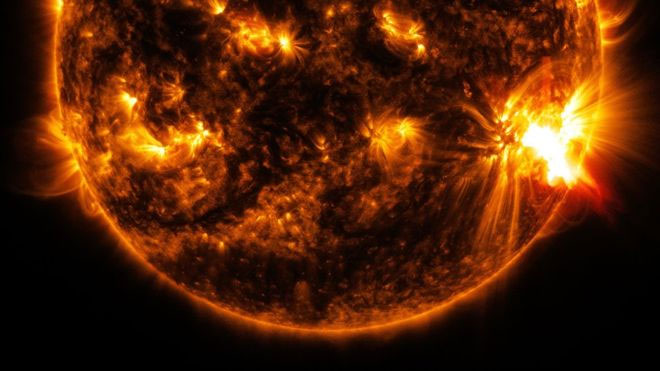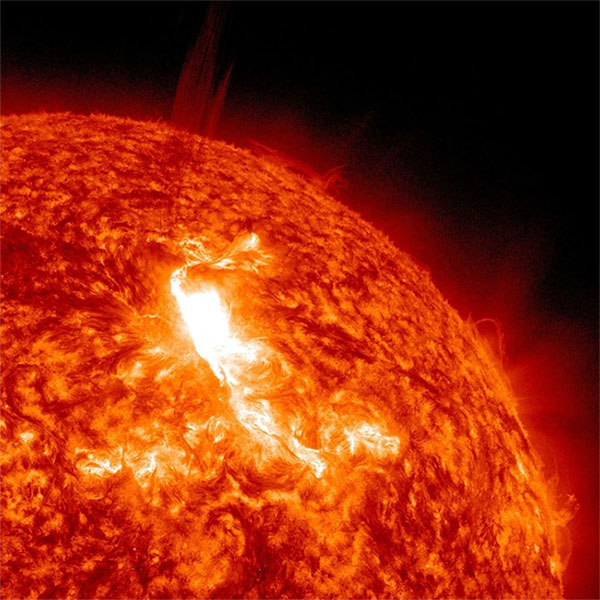Why does the Sun give off a terrible heat but is the space still cold?
Why does the Sun have tremendous heat but the surrounding space is still 'cold'? What a great question.
Unlike the moderate habitat on Earth, in our Solar System there are many areas with varying temperatures. The sun is a ball of gas and fire, with a temperature of about 27 million degrees Fahrenheit (about 15 million degrees Celsius) at the core. The surface temperature of the Sun also reaches 10,000 degrees F (about 5538 degrees C). Meanwhile, "cosmic background temperature" - that is, the space temperature in the area is far enough to escape the impact of temperature coming from the Earth's atmosphere, fluctuating at –455 degrees F ( about –270.5 degrees Celsius. Why can there be such a big difference?
To answer this question, you need to know that heat travels through space in the form of radiation , an infrared energy wave that moves from objects that get hotter to cooler temperatures.
Radiation waves stimulate the molecules they come in contact with, causing them to heat up. This is how heat is transferred from the Sun to Earth through outer space, but it is worth mentioning here that radiation can only heat molecules and matter on its path (and contact directly with radiation). In other areas, the temperature is still as cold as usual. Take for example Mercury: the night temperature of this planet may be as low as 1,000 degrees F (about 538 degrees C) compared to daytime, when there is direct contact with radiation, information from NASA for good.

The sun is a ball of gas and fire, with a temperature of about 27 million degrees Fahrenheit (about 15 million degrees Celsius) at the core.
Let's make a comparison with Earth, a great planet where the atmosphere around you is still warm even when you are standing in the shade and even, in some seasons of the year, the air temperature still at a pleasant warm level even in the darkness of the night. That's because heat is transmitted throughout our beautiful green planet, not just one, but three methods: conduction, convection and radiation. When solar radiation touches and heats molecules in the Earth's atmosphere, these molecules are able to transfer those energies to surrounding molecules. Those molecules then collide and heat the next molecules.The transfer of heat from one molecule to another in this way is called thermal conductivity , and it is a reaction that warms areas outside the path of sunlight.
In contrast, the nature of space is a vacuum , which means that it is basically empty. There are too few gas molecules in space and they are distributed far away, so they do not often "have the opportunity" to collide with each other. So even if the sun heats them with infrared waves, the heat transfer between these molecules through the conduction phenomenon is impossible. Similarly, convection, a form of heat transfer that occurs due to planetary gravity and plays a very important role in the dispersion of heat on Earth, cannot occur in an unattractive environment either. force like in space.
This is exactly what Elisabeth Abel, an engineer - a thermal expert who participated in NASA's DART project, is considering carefully in the process of preparing facilities and equipment for long-term trips time. This is even more meaningful when Abel is participating in the Parker Sun Exploration Project .
As its name suggests, the Parker Solar Probe is part of the solar research mission of the US Aeronautics and Space Agency. This ship will seek to cross the outer layer of the star's atmosphere, called the Sun's corona (corona) , to collect data. In April 2019 the probe approached the Sun at a distance of 15 million miles (about 24.1 million km), the closest it could reach the Sun. The heat shield installed on one side of the probe made it possible to perform this seemingly impossible task.
According to Abel, the task of that heat shield is to make sure that no radiation from the Sun can touch any part of the probe. So while the heat shield is suffering from high temperatures (about 250 degrees Fahrenheit, or 121 degrees Celsius) from our Solar System host star, the probe's temperature remains at much colder - about -238 degrees F (-150 degrees C).

The extreme change of temperature between "ice-cold" space and the Sun's tremendous heat poses unprecedented challenges.
A chief engineer in charge of heat issues of the DART project - a small spacecraft designed to prevent a life-threatening asteroid on Earth, ready to collide with asteroids and pushing it off the dangerous trajectory, Abel is looking for practical measures to control the effects of temperature in deep space. The extreme change of temperature between "ice-cold" space and the Sun's tremendous heat poses unprecedented challenges. Some parts of the spacecraft need to keep the temperature low to avoid short-circuiting, while others need to be heated to work.
The temperature difference up to hundreds of degrees between adjacent areas may sound unbelievable, but the space is everywhere. The really strange thing lies in our own Earth: Amid the bone chill and the burning heat of the universe, the atmosphere of the Earth still keeps things surprisingly pleasant enough for the life exists and develops today.
- Keep science warm
- All Asia struggles to deal with the terrible heat
- Why is the air rising even more cold?
- The terrible cold price covers the United States and Canada
- What would happen if humans were ... 'cold-blooded animals'?
- The terrible heat once swept the globe
- Picking up the cold air to strengthen, Hanoi reduces heat
- The terrible disaster of space exploration
- Adding cold air intensified, the North remained cold
- Welcoming the cold air, the North is about to end the hot sun
- The North is about to welcome a strong cold spell
- China suffered the worst cold spell in 30 years
 Van Allen's belt and evidence that the Apollo 11 mission to the Moon was myth
Van Allen's belt and evidence that the Apollo 11 mission to the Moon was myth The levels of civilization in the universe (Kardashev scale)
The levels of civilization in the universe (Kardashev scale) Today Mars, the sun and the Earth are aligned
Today Mars, the sun and the Earth are aligned The Amazon owner announced a secret plan to build a space base for thousands of people
The Amazon owner announced a secret plan to build a space base for thousands of people